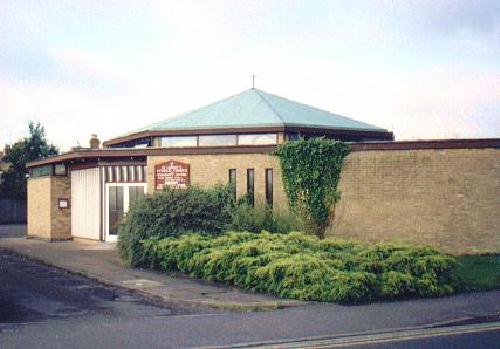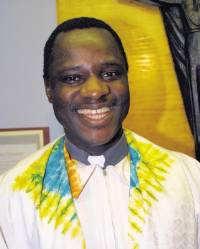|
The
Roman Catholic Church

Roman Catholicism is one of the main divisions of the Christian religion, separate from the Eastern Orthodox Church since 1054, and headed by the pope. Membership is reckoned to be about 600 million worldwide, but concentrated mainly in the poorer regions of Southern Europe, Latin America and the Philippines. The Protestant churches separated from the Catholic with the Reformation in the 16th century and in order to perpetuate the newly established religion, an act of 1559 prescribed a fine of one shilling for every absence from church on a Sunday without lawful or reasonable cause with failure to pay fines followed by committal to prison.
Despite such draconian laws, the Roman Catholics continued to flourish in certain areas and the influence of the gentry was particularly strong and they soon comprised the largest group of persistent non-attenders in the Kesteven area of South Lincolnshire, along with Quakers, Ana Baptists, Presbyterians and independents. The centre was at Irnham where 56 recusants were recorded in 1676 and others at Corby Glen, Lound, Haconby and Stainfield. It was estimated that over 40% of the population of Irnham were Roman Catholic at this time and that John Leyburn, a bishop of that church who visited in 1687, found no fewer than 105 persons to confirm.
In 1911, Mary Ann Duffy, born at Montrose, Scotland, moved to Bourne, and
married a non-Catholic, Mr W H Scotney. She became the only Catholic in the town
but there was no priest, no church and their two children, Bernard and Oliver,
were baptised into the faith at Spalding.
By the 1920s, the number had increased to ten worshippers and mass was being said at one of their homes in Albion Terrace, a row of small cottages in North Street, Bourne. The meetings later moved to a studio at the rear of a newspaper shop at No 13 West Street but
this became too small and the congregation then rented the long room at the Angel Hotel. Services lapsed for two years because there was no visiting priest and a hired bus was subsequently arranged to take worshippers to the Church of Our Lady at Mount Carmel at Corby Glen.
Services then began in the chapel at the Ministry of Labour's Instructional
Centre off West Road and afterwards in the social room of the Co-operative
Society premises at No 17 North Street, rented for 2s. 6d. a week (12½p) with
services being conducted by Father James Power who travelled over by taxi every
Sunday from Deeping St James, where he had recently been appointed chaplain, at
a cost of 2s. 6d which included waiting time.
More space was needed during
the Second World War of 1939-45 because of the influx of servicemen into the area and so the Corn Exchange was hired for services,
and the first Roman Catholic centre for Bourne was established in 1950 on a site
in Exeter Street bought for £100 provided by Ernest Orbell and where a wooden
hut was erected for a further £100 (later to be used as a scout hut). The
temporary church was officially opened in January 1950 as the Church of the
Sacred Heart.
|
New church for Bourne
Catholics
- extract from the Lincolnshire Free Press, 17th January
1950
Wednesday was an
historic day for Roman Catholics in the Bourne district when their new
church in Exeter Street was dedicated by the Bishop of Nottingham. It is
the first Catholic church to be built in the town since the Reformation.
In the intervening years the Catholics in the locality have been most
loyal to their faith by holding services in their homes and other places.
Building began about 18 months ago and was completed last Christmas.
Seating capacity is available for some 150. At the opening ceremony the
vestments of the Bishop and the priests made an impressive scene. Candles
glimmered on the high altar. The Bishop sprinkled holy water during the
procession. In the morning, Father Horspool, of Deeping St James, sang
High Mass and in the afternoon, the Bishop preached and gave pontifical
benediction. Among others present were the Very Rev Leo Avendon
(Grantham), the Very Rev Norbert Ellis (CRP Spalding), Canon Wainwright
and Father Hygnett (Peterborough), Father Douglas Key (secretary to the
Bishop), and included in the congregation were parties from Lincoln,
Spalding, Sleaford and Stamford. |
The church had an expected life span of ten years
although it was subsequently used until the present building was completed in
the autumn of 1976, the first permanent Roman Catholic centre in the town since
the Reformation. The
circular shape excited great interest and even surprise when the design was
announced and Father Patrick Peppard, priest for Bourne, the Deepings and Corby
Glen, commissioned a model of the building from Mr Thomas Wilson of Oakham which
went on public display in the church at Deeping St James. "It will be a dual
purpose church", explained Father Peppard. "We will be able to close off the
sanctuary at one end and use the rest of the building as a hall with the usual
ancillary facilities provided."
Much of
the credit for this development was due to an organisation known as the Altar
Society, formed in 1949 by the early pioneers of the faith in Bourne who were
confident that a building of this stature would eventually be realised. It is
interesting to note that the committee behind this organisation consisted
entirely of ladies who were married to non-Catholic husbands, a total of twelve
members in all.
In
January 1957, the Catholics of Deeping, Bourne and Corby Glen became a parish
that existed until 1984 when the district was re-organised. Corby Glen was
transferred to Grantham and a new parish known as Bourne and Deeping was formed
with Father James O'Hanlon as the first parish priest. The new arrangements were
celebrated with a mass at the Church of Our Lady and St Guthlac at Deeping St
James when thanks were offered for the work done in the previous 29 years.
Today, the Catholics do not have a significant presence in Bourne where the living is
still shared with that at Deeping St James. St Gilbert's Church, named after St
Gilbert of Sempringham, is therefore a modest buildings and one of the first to be completed as part of the St Gilbert's Road development. It stands immediately next to the bus station that was built at the same time, an unfortunate position for despite being separated by a low wall, by virtue of its shape and size it has been known to be mistaken as a cafeteria by visiting bus passengers.
The church, or centre as it was known, can seat 200 worshippers. It was designed for a dual purpose function under one sweep of roof, the sanctuary being at one end that can be closed off while the rest of the floor space is used as a hall for social purposes. The building was dedicated in December 1976 by the Bishop of Nottingham, the Rt Rev James McGuinness.
It had cost £70,000 although more than half of that had been raised by the time
it was opened and the bishop appealed for further funds towards the project.
"The
people in the parish have made sacrifices and have worked hard so that the
centre could be built", he said. "They have been helped by the parishes of Corby
Glen and the Deepings and now the centre has become a focal point where people
can look to for happiness and where Christians of various denominations can meet
and enjoy themselves. I hope that this building will really do good things for
the community in general".
|
PAPAL HONOUR FOR MARGARET
SARLL |
|
One of the highest lay honours of the Roman Catholic
Church was presented to a Bourne lady, Miss Margaret Sarll, in 1974. She
was given a Papal award, the Bene Merenti medal, to mark her church work
spanning forty years and which began when Catholicism had no anchor in the
town.
The presentation was made during a celebration dinner at the Corn Exchange
on Friday 26th October by the Bishop of Nottingham, the Rt Rev Edward
Ellis, who paid tribute to her dedicated service. "When she started her
church work", he said, "there was no Catholic church in Corby Glen or
Bourne and no priest came here but in recent years the diocese has more
than doubled in size. A church has been established in the Deepings and
money is currently being raised for a new church building in Bourne."
The occasion was also the annual dinner of the Bourne Catholic Altar
Society attended by 200 guests, including many members of Miss Sarll's
family who had travelled long distances to be there.
She was then aged 80, having moved to Bourne in 1931 to help her uncle and
aunt, Mr and Mrs J H Berry, with their newsagent's shop in South Street.
There was no church and services were held at the Corn Exchange and the
Co-operative Hall in North Street, now shop and business premises. She was
a founder member of the Altar Society in 1949, formed to assist local
priests in parochial matters and to help raise funds for a permanent
building and at that time £10,000 had been raised towards the final cost
of £50,000. In later years, she was elected president. A bouquet of
flowers was also presented to Miss Sarll, who then lived in the Digby
Court retirement home. She told the gathering: "I have enjoyed every
moment I have worked for the church and I shall continue doing all I can." |
|
NEW PRIEST TAKES OVER
The new priest who took over in February 2008 is
Father Clement Orango, aged 32, who assumed responsibility for the
churches at Bourne and the Deepings but is based at the presbytery in St
Gilbert's Road, Bourne. He is originally from East Africa but arrived in
Lincolnshire after a three year spell of duty in the Sudan. |
 |
|
His family live in the village of Kerubo, Kenya, the
country which has been the scene of violent clashes between rival factions
since the elections in December 2007, but he keeps in constant touch to
ensure that they are safe. |
|
LINCOLNSHIRE RECUSANTS - 1736-37
The following were listed as recusants, persons who
refused to attend Anglican church services, in the parishes where they
lived in 1736-37.
All were listed as "Roman Catholicks".
BULBY (in the parish or Irnham): Peter Brown, Thomas
Beetson, Anthony Langworth, William Beetson, John Parker, Richard Parker
and William Adams.
CAREBY: Francis Hynd, Thomas Collingwood, Joseph Tomlinson, Samuel Mould,
John Brewster, Edward Stephenson and Joseph Collingwood (Popish
Recusants). |
REVISED JULY 2009

Go to:
Main Index Villages
Index
|

